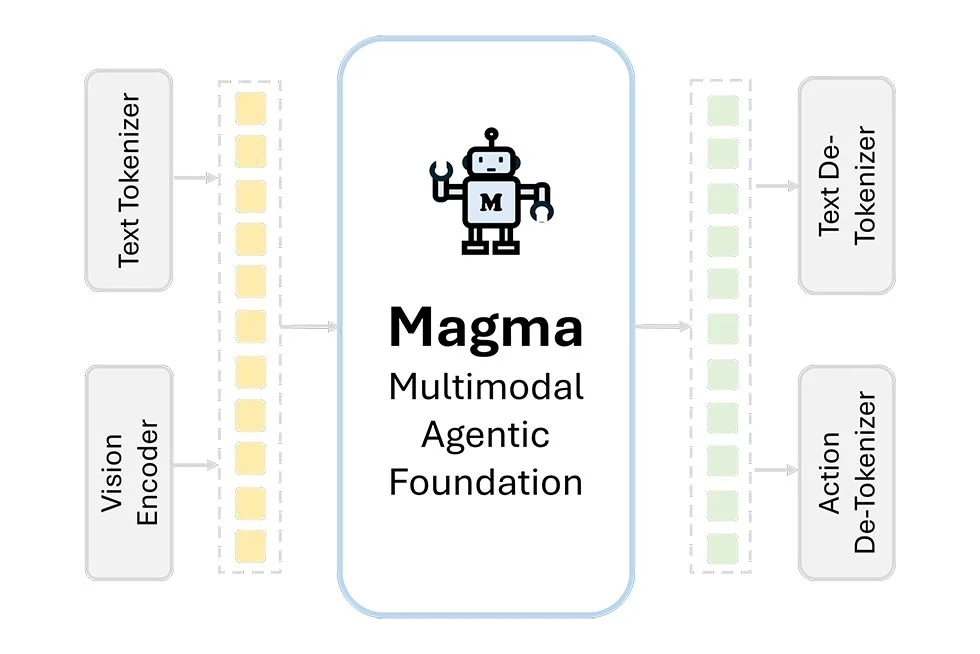Microsoft Magma: A Breakthrough in Multimodal AI Agents
Microsoft has introduced Magma, a groundbreaking multimodal AI foundation model that seamlessly integrates visual and language processing to enable interaction with both digital and physical environments. This innovation represents a significant leap in AI technology, bridging the gap between perception and action. Magma is set to revolutionize areas like software interface navigation, robotics, and video analysis by combining understanding, planning, and execution into a single model.
Table of Contents
- What is Microsoft Magma?
- Key Features of Magma
- How Magma Works
- Applications and Real-World Use Cases
- Future Directions for Magma
- FAQ
- Conclusion
1. What is Microsoft Magma?
Microsoft Magma is a multimodal AI foundation model that integrates the ability to process multiple forms of input—text, images, and videos—into a unified framework. Unlike traditional AI systems that rely on separate models for perception (e.g., image recognition) and action (e.g., robotic control), Magma combines these capabilities. This allows it to perform complex, interactive tasks like navigating software interfaces and controlling robotic systems.
Magma’s development is a step toward agentic AI, a concept where AI systems can autonomously plan and execute actions to achieve specific goals based on user input. This positions Magma as a versatile tool for applications in both the digital and physical worlds.
2. Key Features of Magma
Magma’s design and functionality set it apart from traditional AI models. Below are its standout features:
2.1 Multimodal Understanding and Action
- Magma processes text, images, and videos simultaneously to perform tasks requiring a combination of language comprehension and visual reasoning.
- Unlike older systems, Magma integrates perception and control into a single model, eliminating the need for separate AI modules.
- Example: Magma can interpret a user’s textual instructions and execute actions like navigating a user interface or manipulating robotic arms.
2.2 Agentic AI Capabilities
- Magma is capable of autonomous decision-making. It formulates plans and executes them to achieve predefined goals.
- Example: If tasked with organizing items in a warehouse, Magma can analyze the environment, create a step-by-step plan, and operate robotic systems to complete the task.
2.3 Advanced Pretraining Techniques
- Magma’s training incorporates heterogeneous datasets that include images, videos, and robotics data.
- Unique methods like Set-of-Mark (SoM) for object-action grounding and Trace-of-Mark (ToM) for sequential planning enable it to understand spatial and temporal relationships.
2.4 State-of-the-Art Performance
- Magma has achieved top-tier results in a variety of tasks:
- UI navigation: Controlling software interfaces with precision.
- Robotic manipulation: Handling physical objects with accuracy.
- Video question-answering: Interpreting and responding to queries based on video content.
3. How Magma Works
Magma’s architecture is designed to unify multimodal perception and action planning within a single framework. Here’s a closer look at its functionality:
3.1 Data Pretraining
- Magma is pretrained on large-scale datasets that include:
- Images and videos for visual understanding.
- Textual data for language comprehension.
- Robotics datasets for action grounding and planning.
- This diverse training enables Magma to generalize effectively across tasks.
3.2 Action Grounding with SoM and ToM
- Set-of-Mark (SoM): Helps the model identify actionable objects in visual data.
- Trace-of-Mark (ToM): Enables the model to plan sequential actions over time.
- These techniques allow Magma to demonstrate spatial-temporal intelligence, essential for both digital and physical task execution.
3.3 Multimodal Fusion
- The model integrates inputs from multiple modalities (e.g., combining text instructions with video footage) to generate context-aware responses.
4. Applications and Real-World Use Cases
Magma’s versatility opens the door to numerous applications across industries:
4.1 Robotics
- Magma can control robotic systems for tasks like assembly-line operations, warehouse management, and household assistance.
- Example: A robot equipped with Magma can autonomously pick and place items based on visual and textual instructions.
4.2 Software Automation
- The model excels at navigating user interfaces, making it a valuable tool for automating repetitive tasks in enterprise software.
- Example: Magma can complete form-filling tasks by interpreting on-screen prompts and executing actions like clicking buttons.
4.3 Video Analysis and Interpretation
- Magma’s ability to analyze video content has applications in surveillance, entertainment, and education.
- Example: It can answer questions about a video’s content, such as identifying key events or summarizing scenes.
5. Future Directions for Magma
Microsoft envisions several advancements for Magma:
5.1 Enhanced Training Datasets
- Expanding datasets to include more diverse and complex scenarios will further improve Magma’s generalization capabilities.
5.2 Ethical Considerations
- Future iterations will focus on ensuring safety, fairness, and regulatory compliance, addressing concerns about AI bias and misuse.
6. FAQ
Q1: What makes Magma different from existing AI models?
Magma combines perception and action within a single framework, allowing it to process multimodal inputs and autonomously execute tasks.
Q2: What industries can benefit from Magma?
Industries like robotics, healthcare, software automation, and video analysis stand to benefit significantly from Magma’s capabilities.
Q3: How is Magma trained?
Magma is pretrained on large datasets that include images, videos, and robotics data, using innovative techniques like SoM and ToM for action grounding and planning.
7. Conclusion
Microsoft Magma represents a groundbreaking advancement in AI technology, bridging the gap between perception and action through its multimodal capabilities. By integrating visual and language processing with action planning, Magma is poised to revolutionize industries ranging from robotics to software automation.
As Microsoft continues to refine Magma, its potential applications will grow, bringing new possibilities in AI capabilities. Stay tuned as Magma evolves into a cornerstone of multimodal and agentic AI innovation.
